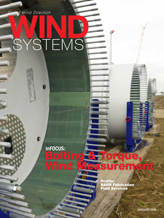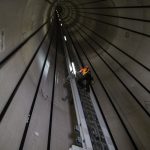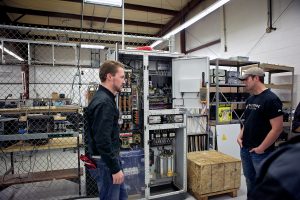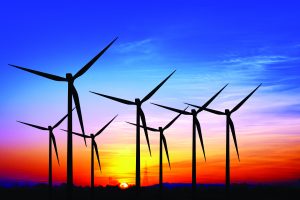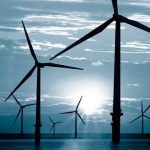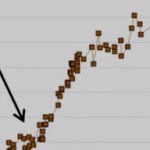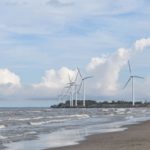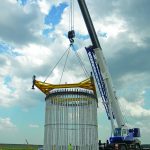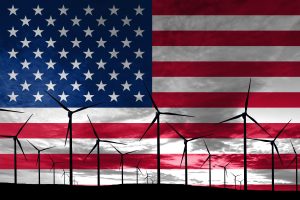Editor’s note: This article on torque loading is presented in two parts. Part 2 will discuss the specific industry standards for wind-turbine drivetrains and will appear in the February issue.
As wind energy has moved from a niche market to mainstream, the industry has focused more on the lowest cost of energy or LCOE. Technological improvements and larger rotor sizes have moved the industry forward, frequently positioning wind as the lowest cost energy source.
Recently more attention has been focused on controlling the cost of turbine damage, downtime, and component failures to improve the LCOE. To gain control, a more thorough understanding of why major components, such as gearboxes, are failing prematurely is needed.
For bearing and gear designs, manufacturers require high fidelity load cases from the OEMs to optimize their designs for performance, costs, and life. Load cases are coming under renewed scrutiny, as components reach the end of service life prior to the predicted life calculations. New detailed design standards have improved turbine reliability, but more may be needed to achieve the component design life targets.
Understanding Loads
Loads are a significant consideration when analyzing drivetrain component performance. Knowing what loads were present, and if the bearing or gear is overloaded, help identify the root cause of reduced component life.
Rolling Contact Fatigue analyzes when normal loading will lead to a “wear-out” condition. It is an estimation of when average useful life is reached. This analysis is straightforward, as long as you have an accurate load estimate and the time at load conditions. In bearings, loads are important; just a 23 percent increase in loads will reduce the predicted bearing life by a factor of two.

Transient loads are more difficult to model or to build into wind-turbine design standards and other equipment with variable conditions. Transients are extreme peak loads or rapidly shifting loads that occur in the drivetrain, which may be two-to-three times higher than the nominal loads. However, these loads may only make up 0.05 percent of the total lifetime in the load spectrum. Because component durability is so dependent on the loading, extreme transient loads may result in the difference between 20 years or 20 months of component life. It is essentially guaranteed that turbines will experience some level of transient loads because they see highly variable locations, frequency of wind gusts, grid fault frequency, turbulence, control systems, frequency of sensor failures, and other variables.
With so many variables and differences in loading between turbines in the same site and from site-to-site around the world, it is challenging to fully understand the loading conditions to use in the calculation models.
Operating Loads Defined
The large number of premature failures in gearboxes in the late 1980s prompted an investigation into high-torque transients that occur during stopping events. In 1990, Brian McNiff, Walt Musial, and Robert Errichello published a report sponsored by SERI (Solar Energy Research Institute) that stated:
“As mentioned, the undampened mechanical brakes stop a wind turbine abruptly. In such severe stops, and even in the damped version, some of the kinetic energy is stored momentarily as elastic strain energy in the gears, shafts, and couplings. After the rotor has stopped, the strain energy is released when these drive train elements torsionally unwind. During this period, the gear teeth unload, travel through the backlash, and impact on their backsides. They then rebound, travel through the backlash, and impact on their front sides. These rapid torque reversals may be repeated several times while the transient vibration decays. Impact may cause very high stresses on the gear teeth. Again, gear life is probably overestimated for both mechanical brakes by the model due to the inability of the present analysis to include these torque reversals. The impact stresses could be determined in a future study with a nonlinear, dynamic analysis and/or actual measurement.”

This work led to the first AGMA/AWEA meeting in 1993. In 1996, the first U.S. wind-specific design information sheet, AGMA/AWEA 921-A97 was published. This guideline defined operating loads for the first time.
Operating Loads
As defined by this standard, operating loads are as follows:
- Long periods of small oscillations while the unit is stopped by the parking brake and the rotor is buffeted by wind.
- Long periods of low-speed, low loads during light winds.
- Long periods of high-speed, low loads when winds are below the cut-in speed (minimum speed at which a turbine can connect to the utility’s power grid and start generating power).
- High transient loads when the generator connects to the power grid.
- Rapid load fluctuations during normal operation.
- High transient loads during braking. Such loads, although infrequent, can be damaging.
Defining the load spectrum for each condition is a difficult task due to the uncertainty of predicting loads. However, it was thought at the time that experience made these predictions more reliable. AGMA/AWEA 921 tells how to assemble load spectra that include both wind loads and transient loads that occur during start-up (connection to the power grid), rapid blade pitch change, and braking.

The standard provided guidelines for material properties and metallurgies and specified that wind gear sets meet the AGMA 901-A92 standards. It further defined recommended practices on bearing fitting and preferred bearing types. Lubrication, quality assurance, and maintenance practices were also defined, creating a standard with a better understanding of how to design better turbines. The standard mentions severe transient loads, but did not directly address them.
Design Standards Approved
Fast forward to early 2000s, and even with standards, gearboxes were not meeting design lifetime requirements. A true design standard was needed.
In 2003, ANSI/AGMA/AWEA 6006-A03 was approved, and became an official American National Standard in 2004. The standard requires all transient loads be included in a load description document as annotated time series. It states:
“The torque spectrum shall include all fatigue loads, including all external transient loads such as brake loads, if applicable.” It provides several examples of transient load cases, including: transient starting loads due to generator control actions; loads due to motoring; transient stopping loads from aerodynamic and mechanical brakes; rotor mass imbalance or aerodynamic imbalance due to blade pitch differences; and fault induced control actions.
Standard 6006-A03 specifically makes an important distinction between extreme torque/extreme loads, and extreme events. It states in part:
“Extreme torque shall be specified by the wind-turbine manufacturer: torque level; number of occurrences; source, such as rotor, generator or brake. Extreme loads shall not be included in the load spectrum … The extreme load is that load from any source, either operating or non-operating, that is the largest single load that the gearbox will see during its design life beyond which the gearbox no longer satisfies the design requirements … The maximum one-time load event for a gearbox is likely to be a consequence of other events such as an emergency brake stop, generator short circuit fault or utility grid event. The wind-turbine designer should determine the likely magnitude and probability of this maximum load and specify it separately to the gearbox designer.”

This requires the designers to consider extreme transient loads in the load spectrum, but to evaluate extreme events separately. This may be the best approach available, but it does magnify the importance of correctly and conservatively estimating the number of such extreme events. In 2009, Francisco Oyague published an NREL Technical Report titled Gearbox Modeling and Load Simulation of a Baseline 750-kW Wind Turbine Using State-of-the-Art Simulation Codes. The report offered a few hypotheses to explain gearbox failure, including:
- Absence of a number of load cases, relevant to the design process.
- Transfer of non-torsional loads between drivetrain components.
- The lack of standardized bearing-life calculations.
- Poor communication between non-integrated engineering teams for various key components.
The report discussed revealing missing load conditions by development of a number of analytical models that sequentially increase in complexity, which are capable of reproducing the dynamic behavior of the internal components of the drivetrain. The models developed were offered freely to improve information sharing and ultimately increasing the transparency of the design process.
Sources
- AGMA/AWEA. (1996). Recommended Practices for Design and Specification of Gearboxes for Wind Turbine Generator Systems. AGMA/AWEA 921-A97
- ANSI/AGMA/AWEA. (2003). Standard for Design and Specification of Gearboxes for Wind Turbines. ANSI/AGMA/AWEA 6006-A03
- IEC. (2012). Wind turbines – Part 4: Design requirements for wind turbine gearboxes. IEC standard 61400-4:2012
- McNiff, B., Errichello, R., (1997) New guidelines promise reliable wind-Turbine gearboxes: What they mandate. http://www.machinedesign.com/Sustainable-Engineering/New-Guidelines-Promise-Reliable-Wind-Turbine-Gearboxes-What-They-Mandate. [Accessed 8 Dec. 2017].
- McNiff, B., Musial, W., Errichello, R., (1990) Variations in Fatigue Life for Different Wind Turbine Braking Strategies SERI/TP-257-3984. Available at: www.nrel.gov/docs/legosti/old/3984.pdf [Accessed 8 Dec. 2017].
- Nappi, G., Introduction of the new gearbox design standard for wind turbine generators: a gap analysis between IEC 61400-4 and ISO 81400-4. proceedings.ewea.org/annual2014/conference/posters/PO_036_EWEApresentation2014.pdf
- Oyague, F. (2009). Gearbox Modeling and Load Simulation of a Baseline 750-kW Wind Turbine Using State-of-the-Art Simulation Codes. [online] Nrel.gov. Available at: www.nrel.gov/docs/fy09osti/41160.pdf [Accessed 8 Dec. 2017].
















